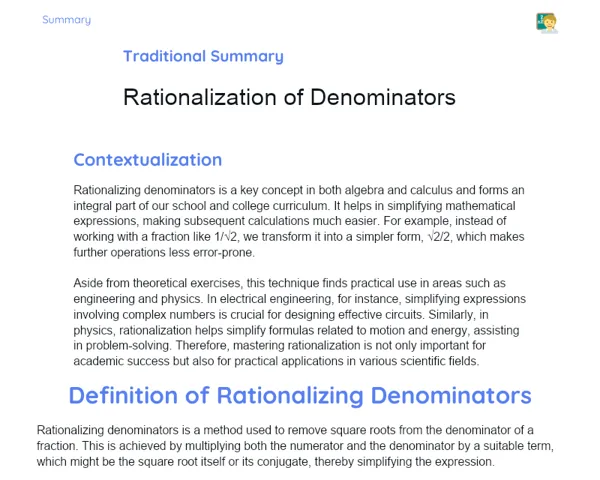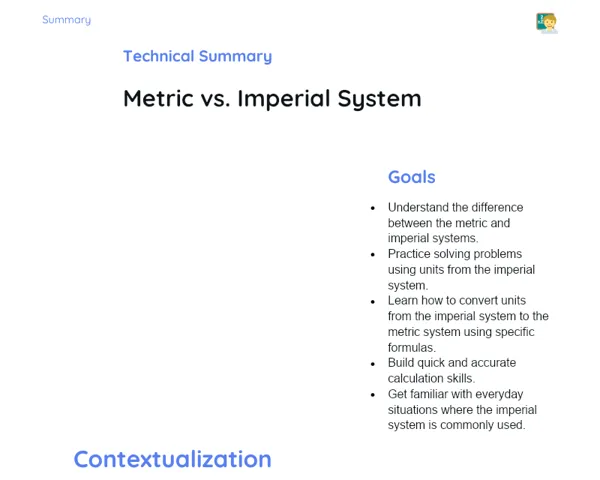Summary Tradisional | Spatial Geometry: Volume of Cones
Contextualization
Spatial Geometry is an important branch of Mathematics that investigates three-dimensional shapes like cones, cylinders, and spheres. A cone is a three-dimensional shape featuring a circular base with a vertex that is positioned above the base. Its most distinctive trait is its conical form, which we see in everyday items such as party hats, traffic cones, and even natural formations like volcanoes. Being able to calculate the lateral surface area and the total area of a cone is vital in various sectors including engineering, architecture, and even interior design.
In this lesson, we will concentrate on two key skills: calculating the lateral surface area and the total area of a cone. The lateral surface area refers to the curved surface, while the total area encompasses both the lateral surface area and the area of the circular base. These calculations serve as a foundation for tackling practical issues, such as figuring out how much material is necessary to cover the surface of a cone or the surface area of a conical room's walls. By grasping these concepts, students will be equipped to apply geometric principles in real-life scenarios, thereby aiding the resolution of intricate problems across various fields.
To Remember!
Definition and Elements of the Cone
A cone is a three-dimensional shape consisting of a circular base and a vertex located above the base. The line connecting the vertex to the center of the base is called the height of the cone. Additionally, the line connecting the vertex to any point on the edge of the base is referred to as the slant height. The base itself is a flat circular surface, while the part joining the base to the vertex forms a curved surface. Grasping these elements is fundamental for applying the geometric formulas that compute the area and volume of the cone.
These components are vital for formulating the equations to determine the lateral surface area and the total area of the cone. The slant height, for instance, plays a crucial role in the formula for lateral surface area, as it dictates the extent of the curved surface around the cone. The height is key for finding the cone's volume, although it is not the primary focus of this lesson. However, the height can also be used alongside the radius of the base to find the slant height using the Pythagorean Theorem.
Understanding the components of a cone is essential for accurately applying the formulas. Without this comprehension, the calculations can get confusing and lead to mistakes. Therefore, it's significant for students to familiarize themselves with these terms and to be able to identify each element in various geometric problems. Visual aids and diagrams can be tremendously beneficial for this foundational understanding.
-
Circular base
-
Vertex
-
Height
-
Slant height
Formula for Lateral Surface Area
The formula for the lateral surface area of a cone is expressed as A_l = π * r * g, where A_l is the lateral surface area, r is the radius of the base, and g is the slant height. This formula emerges from the geometry concerning the cone's curved surface. The slant height can be visualized as the incline of the cone, while the radius represents the distance from the center of the base to any point on the edge. Multiplying these two values and then by π yields the lateral surface area.
To grasp this formula, it's important to understand how each component functions. The base radius (r) determines the size of the cone's base circumference, while the slant height (g) specifies the extent of the curve stretching from the vertex to the base. The constant π (pi) is essential for calculating circular areas and appears in numerous geometric formulas relating to circles and spheres.
The practical use of this formula can be observed in many instances, such as when figuring out the amount of material required to cover the surface of a cone, whether that be for a party hat or a funnel. Mastering the calculation of lateral surface area is crucial for solving both practical and complicated problems in domains like engineering and product design.
-
A_l = π * r * g
-
r is the radius of the base
-
g is the slant height
Formula for Total Area of the Cone
The formula for the total area of the cone is A_t = π * r * (r + g), where A_t signifies the total area, r represents the radius of the base, and g denotes the slant height. The total area is the aggregate of the area of the circular base and the lateral surface area. The area of the base is calculated with the formula for the area of a circle (π * r²), while the lateral surface area is derived as detailed above (π * r * g).
This formula holds significance as it presents a comprehensive view of the total area enveloping the cone, which includes both the base and the lateral surface. This is crucial in practical scenarios where one needs to calculate the entire amount of material necessary to cover a cone, akin to construction projects or design initiatives.
To utilize this formula, one must first find the area of the base and lateral surface area separately, and then sum them up. This ensures that all parts of the total area are accounted for, minimizing common calculation errors.
-
A_t = π * r * (r + g)
-
Includes the area of the base and lateral surface
-
Essential for comprehensive area calculations
Applications in Real-World Problems
The principles governing the calculation of cone areas have a variety of practical applications in daily life. For instance, in the construction industry, one often encounters cone-shaped structures, necessitating total area calculations to ascertain how much covering or paint is needed. A practical example would entail computing the area of the walls in a cone-shaped room, which requires using the formulas for both lateral surface area and total area.
Additionally, in interior design, a sound understanding of curved surface areas is pivotal for crafting visually appealing and functional designs. Designers can apply these calculations to develop decorative and functional cone-shaped elements, guaranteeing that every detail is executed precisely.
Moreover, in fields like engineering and architecture, a firm grasp of spatial geometry is indispensable for developing stable and efficient designs. The cone's shape is frequently employed for its structural advantages, as seen in conical roofs and storage silos. Therefore, knowing how to compute the areas of these cones is vital for ensuring safety and efficiency in constructions.
-
Construction
-
Interior design
-
Engineering and architecture
Key Terms
-
Cone: Three-dimensional shape with a circular base and vertex.
-
Radius (r): Distance from the center of the base to the circumference.
-
Slant height (g): Line connecting the vertex to any point on the circumference of the base.
-
Height (h): Perpendicular line connecting the base to the vertex.
-
Lateral Surface Area (A_l): Area of the curved part of the cone.
-
Total Area (A_t): Sum of the area of the base and lateral surface.
-
Pythagorean Theorem: Employed to determine the slant height when height and radius are known.
Important Conclusions
In this lesson, we delved into spatial geometry, particularly focusing on cones, which are three-dimensional shapes frequently encountered in both natural and man-made environments. We covered the definition and elements of a cone, including the circular base, the vertex, the height, and the slant height, all of which are critical for grasping the related geometric formulas.
We learned how to compute the lateral surface area and total area of a cone using the formulas A_l = π * r * g and A_t = π * r * (r + g), respectively. These computations are vital for addressing practical issues, such as figuring out how much material is required to cover a cone, a concept highly relevant in professions like engineering, architecture, and interior design.
Lastly, we examined how these ideas apply to real situations, such as calculating the area of the walls in a cone-shaped room. The capability to apply spatial geometry to practical scenarios enhances students' understanding and ability to tackle complex problems in diverse situations, reinforcing the importance of the knowledge acquired.
Study Tips
-
Review the practical examples discussed in class and try to solve similar problems to solidify your grasp of the formulas and concepts.
-
Utilize visual aids such as diagrams and three-dimensional models to better visualize the cone's components and their relationships in the formulas.
-
Practice calculating cone areas in various everyday contexts, like construction or design projects, to make the concepts more practical and relevant.



